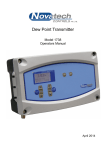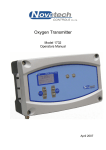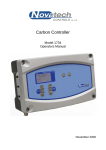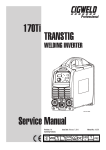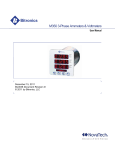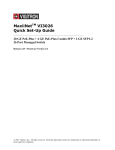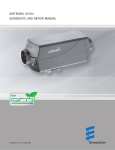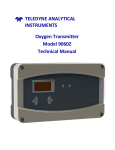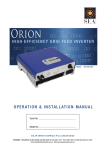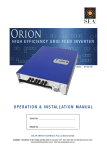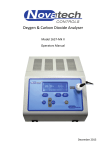Download 1735 Operators Manual
Transcript
Water Vapour Transmitter Model 1735 Operators Manual September 2015 TABLE OF CONTENTS 1. IMPORTANT NOTICES ................................................................................................................................ 3 1.1 CAUTIONS .................................................................................................................................................. 3 1.2 W ARNING SYMBOLS.................................................................................................................................... 4 2. INTRODUCTION ........................................................................................................................................... 5 2.1 DRYER MODES OF OPERATION.................................................................................................................... 5 2.2 1735 TRANSMITTER HARDWARE ................................................................................................................. 7 3. DEVICE SPECIFICATIONS .......................................................................................................................... 9 3.1 HARDWARE SPECIFICATIONS ....................................................................................................................... 9 3.2 OPERATIONAL SPECIFICATIONS ................................................................................................................. 10 3.2.1 Scaling of Analog Outputs Channel #1 and Channel #2 ................................................................. 10 3.2.2 Local Display of Process Variables ................................................................................................. 10 4. DISPLAY AND KEYPAD ............................................................................................................................ 11 4.1 RUN MODE DISPLAY ................................................................................................................................. 11 4.2 TOP LINE DISPLAY .................................................................................................................................... 12 4.3 KEYPAD ................................................................................................................................................... 13 4.3.1 Keypad in Run Mode ....................................................................................................................... 13 4.3.2 Keypad in the Setup Menu .............................................................................................................. 14 4.3.3 Transmitter Information Screen ....................................................................................................... 15 5. SETUP MENU ............................................................................................................................................. 17 5.1 SETUP MENU FUNCTION SUMMARY ........................................................................................................... 17 5.2 SETUP MENU DISPLAY .............................................................................................................................. 17 5.3 CHANGING MENU OPTIONS ....................................................................................................................... 17 5.3 SETUP MENU FUNCTIONS ......................................................................................................................... 18 5.3.1 Probe 1 Offset ................................................................................................................................. 18 5.3.2 Lower Line Items ............................................................................................................................. 18 5.3.4 Oxygen Damping ............................................................................................................................. 19 5.3.5 Spike Suppression .......................................................................................................................... 19 5.3.6 Spike Trip Level ............................................................................................................................... 20 6. ALARMS ..................................................................................................................................................... 21 6.1 CHECKING AND ACCEPTING AN ALARM....................................................................................................... 22 6.1.1 Current Alarms ................................................................................................................................ 22 6.1.2 Alarm Log ........................................................................................................................................ 22 6.2 ALARM RELAYS ........................................................................................................................................ 23 6.3 COMMON ALARMS .................................................................................................................................... 23 6.4 SELECTABLE PROCESS ALARMS ................................................................................................................ 24 6.5 W ARNING MESSAGES ............................................................................................................................... 25 7. GAS CALIBRATE AND PURGE ................................................................................................................ 27 7.1 ACTIONS THAT OCCUR WHEN THE GAS SOLENOID BUTTONS ARE PRESSED ................................................. 28 8. INDEX .......................................................................................................................................................... 29 Copyright NOVATECH CONTROLS PTY LTD — 2015 Edition - September 2015 This manual describes the transmitter firmware version 1.26, September 2015 Neither the whole nor any part of the information contained in, or the product described in, this manual may be adapted or reproduced in any material form except with the prior written approval of Novatech Controls Pty Ltd (Novatech). The product described in this manual and products for use with it, are subject to continuous developments and improvement. All information of a technical nature and particulars of the product and its use (including the information in this manual) are given by Novatech in good faith. However, it is acknowledged that there may be errors or omissions in this manual. A list of details of any amendments or revisions to this manual can be obtained upon request from Novatech Controls Technical Enquiries. Novatech Controls welcome comments and suggestions relating to the product and this manual. All correspondence should be addressed to: Technical Enquiries Novatech Controls Pty Ltd 309 Reserve Road, Cheltenham Victoria 3192 Australia Tel: Fax: Email: Web site: +61 3 9585 2833 +61 3 9585 2844 [email protected] http://www.novatech.com.au/ Novatech Controls or their authorised dealers should carry out all maintenance and service on the product. Novatech Controls can accept no liability whatsoever for any loss or damage caused by service or maintenance by unauthorised personnel. This manual is intended only to assist the reader in the use of the product, and therefore Novatech Controls shall not be liable for any loss or damage whatsoever arising from the use of any information or particulars in, or any error or omission in, this manual, or any incorrect use of the product. Operators Manual 2 September 2015 1735 Water Vapour Transmitter 1. IMPORTANT NOTICES This manual is a shortened version of the 1735 Water Vapour Transmitter product manual to be used by the operator. It does not cover the commissioning, calibration or servicing of the 1735 Water Vapour. If more detailed information is required than what is provided in this manual please refer to the more detailed 1735 Water Vapour Transmitter Technical Manual. Both manuals are supplied with each transmitter and are also available to download at the Novatech Controls website. http://www.novatech.com.au/1735 It is assumed in this manual that the transmitter has been installed by qualified personal and that the wiring to the main power supply, the oxygen probe and all the associated signal devices comply with the local safety codes and regulations. 1.1 Cautions Please read the safety information below before connecting power to the transmitter. CAUTION 1 The probe heater is supplied with MAINS VOLTAGE. This supply has electrical shock danger to maintenance personnel. Always isolate the transmitter before working with the probe. The EARTH wire (green) from a heated probe must ALWAYS be connected to earth. CAUTION 2 Combustion or atmosphere control systems can be dangerous. Burners must be mechanically set up so that in the worst case of equipment failure, the system cannot generate explosive atmospheres. This danger is normally avoided with flue gas trim systems by adjustment so that in the case of failure the appliance will not generate CO in excess of 400 ppm in the flue. The CO level in the flue should be measured with a separate CO instrument, normally an infrared or fuel cell type. CAUTION 3 The oxygen probe is heated to over 700°C (1300°F) and is a source of ignition. Since raw fuel leaks can occur during burner shutdown, the transmitter has an interlocking relay that removes power from the probe heater when the main fuel shut-off valve power is off. If this configuration does not suit or if it is possible for raw fuel to come into contact with a hot oxygen probe then the Model 1735 Transmitter with a heated probe will not be safe in your application. An unheated probe can be utilised in such applications, however the oxygen readings are valid only above 650°C (1200°F). CAUTION 4 FIL-3 filter. If the optional FIL-3 has been fitted to the 1231 probe in this installation, please read the Important Notice in the Technical Manual. CAUTION 5 The heater is supplied from the mains power directly, and the temperature is controlled at 720°C (1330°F). The outside of the process end of the probe can get to temperatures that are dangerous to touch. Wear insulating gloves when handling a probe that has been on. September 2015 1735 Water Vapour Transmitter Operators Manual 3 1.2 Warning Symbols Danger, high voltage. Risk of electrical shock. Caution hot surface. Caution, risk of danger. See additional information in the manual. Operators Manual 4 September 2015 1735 Water Vapour Transmitter 2. INTRODUCTION The Novatech 1735 Water Vapour Transmitter is designed for measuring water vapour in drying and baking applications, where the drying temperature is above the maximum limit of conventional relative humidity sensors (which are limited to 130-150°C) or a more robust sensor is preferred. The transmitter signal can be used with a conventional controller to improve the efficiency of industrial drying or baking applications, as well as to optimise the quality of the product being dried or baked. 2.1 Dryer Modes of Operation There are several methods that the 1735 Water Vapour Transmitter can use to calculate water vapour: 1. Mode Option in Commissioning Menu 4 1231 oxygen probe installed Second probe installed RGS temp sensor 1 Indirect Fired, Single Zone Yes No No 2 Indirect Fired, Two Zones Yes 1231 No 3 Direct Fired, Fixed Combustion Yes No No 4 Direct Fired, Single Probe Yes No Yes 5 Direct Fired, Refrigerated Gas Yes No No 6 Direct Fired, Probe + RGS Yes RGS-17 Yes 7 Directly Fired, External Dry Oxygen Yes No No 8 Directly Fired Two Zone, External Dry Oxygen Yes 1231 No Indirectly Heated Dryers and Ovens, Single Zone The in-situ 1231 probe measures the oxygen content within the drying chamber and calculations are performed to determine how much of the air space is taken up by water vapour. For indirectly heated dryers or ovens, an oxygen probe and transmitter are all that is required. The oxygen probe uses ambient air as a reference gas. 2. Indirectly Heated Dryers and Ovens, Two Zones Two independent in-situ 1232 probes measure oxygen content at two points within the drying chamber to calculate water vapour for each zone. The 1735 Transmitter can be configured to independently display and retransmit water vapour for each individual zone on separate channels for comparison or redundancy. Both oxygen probes use ambient air as a reference gas. 3. Directly Heated Dryers and Ovens with Constant Combustion If the dryer or oven has a fixed combustion system (fixed firing rate), where the reduction of oxygen due to combustion is constant. In this application a reference gas sensor may not be necessary to condition reference gas from within the dryer. The dryer or oven oxygen level can be assumed as a fixed value and entered into the transmitter during commissioning. The water vapour percentage is measured by gravimetric methods to calculate the correct initial setting. September 2015 1735 Water Vapour Transmitter Operators Manual 5 NOTE: The next two methods for calculating water vapour utilize gas extracted from the dryer which is conditioned and used as the reference gas for the oxygen probe. While these two methods reduce the number of oxygen probes required to obtain a water vapour measurement in a direct fired application, the process of extracting gas requires sampling and conditioning equipment additional to the 1735 Transmitter. It is not recommended that process gas be used as reference gas for the 1231 in-situ oxygen probe unless it has been cleaned of any process related residue, otherwise it may adversely affect the accuracy of readings and significantly reduce the operational life of the probe. 4. Directly Heated Dryers and Ovens, Single Probe Differential Measurement Using Extracted and Ambient Cooled Process Gas Used in a system where a single in-situ oxygen probe is used to calculate water vapour by simultaneously extracting process gas from the dryer and cooling this to ambient temperature to produce a cool but saturated reference gas. This cooled gas is used in place of ambient air as the oxygen probe reference gas allowing the probe to measure the difference in oxygen concentration between the wet process gas in the dryer and the cooled process gas. By measuring the process gas temperature the water vapour percentage of the process can be calculated. 5. Directly Heated Dryers and Ovens, Single Probe Differential Measurement Using Extracted and Refrigerated Process Gas Used in a system where a single in-situ oxygen probe is used to calculate water vapour by simultaneously extracting process gas from the dryer and actively refrigerating this to 0°C to produce a reference gas. The same as the previous method this reference gas is used in place of ambient air as the oxygen probe reference gas to measure the difference in oxygen concentration between the wet process gas in the dryer and the cooled process gas. By cooling to a known temperature a separate temperature sensor is not required, and by knowing the water vapour concentration in the reference gas it is possible to calculate the water vapour in the dryer. 6. Directly Heated Dryers and Ovens, Two Oxygen Sensors to Measure Wet And Dry Oxygen Concentration The recommend method for measuring water vapour where dryers or ovens use direct fired combustion. Because the combustion oxygen can vary, two oxygen sensors are required to calculate water vapour. In this mode the transmitter uses an in-situ 1231 oxygen probe to measure the wet gas oxygen level in the dryer and a second RGS-17 Reference Gas Sensor to read the dry gas. The dry measurement of oxygen in the dryer or oven is measured after removing most of the water vapour. A temperature sensor is used to measure the temperature of the gas as it enters the RGS-17 to compensate for the moisture remaining in the gas stream. 7. Directly Heated Dryers and Ovens Using an External Dry Oxygen Measurement by Means of a Scaled 4-20mA Signal In this method two oxygen sensors are still used to calculate water vapour similar to the previous method, however it may be preferred to use a separate technology or system to measure the dry oxygen content in the dryer or oven rather than the RGS-17 Reference Gas Sensor. A 1231 in-situ oxygen probe is still used read the wet gas oxygen level in the dryer and a third party oxygen sensor is used to read the dry gas, which is scaled 0-25% dry oxygen and fed into the transmitter as a 420mA signal. 8. Directly Heated Dryers and Ovens Using an External Dry Oxygen Measurement by Means of a Scaled 4-20ma Signal, Two Zones This method is identical to the above method, but extends the functionality to use a second 1231 in-situ oxygen probe for a second independent zone. The dry oxygen reading, which is fed into the transmitter as a 4-20mA signal is used for both zones. Each zone can be independently displayed and retransmitted on separate channels for comparison or redundancy. Operators Manual 6 September 2015 1735 Water Vapour Transmitter 2.2 1735 Transmitter Hardware The 1735 Water Vapour Transmitter has a variety of user-selectable functions. They are simple to use because each selection is menu driven. For options you are not sure about, read the manual on that particular item in Chapter 5, Setup Menu. Features include:Inputs Two zirconia oxygen probe, heated or unheated Furnace, kiln or flue thermocouple, field selectable as type K or J Reference gas sensor (RGS) temperature. Solid state sensor. Main flame established safety interlock (for heated probes only) Purge flow switch Outputs Two linearised 4-20mA or 0-20mA DC isolated outputs, maximum load 1000 The output function and the range are field selectable Common alarm relay (programmable) Three other alarm relays with selectable functions Computer RS 232 or RS 485 terminals for connection of a computer terminal or printer for diagnostics of the transmitter, probe or drying process. This connection is intended for network connection to a computer, DCS or PLC using MODBUS protocol. Display Multi font graphical display Large characters for the top line Selectable top line function Water Vapour range from 0 to 100% Dew point from -50°C to 100°C (-58°F to 212°F) Mixing Ratio from 0 to 10,000 g/kg water vapour/dry process gas Specific Humidity 0 to 1000 g/kg water vapour/process gas -30 Oxygen from 1x 10 to 100% Multiple lower line items for the secondary functions. eg Probe temperature, Dew point probe #2 Alarm display mode that shows the time the alarm occurred, acceptance time and the cleared time Alarm log mode that keeps the time the alarm occurred, the acceptance time and the time the alarm was cleared for the last 4,000 alarms Power Universal mains supply voltage, 100 to 240VAC Automatic detection of mains voltage and frequency and set the power control accordingly September 2015 1735 Water Vapour Transmitter Operators Manual 7 This page has been intentionally left blank. Operators Manual 8 September 2015 1735 Water Vapour Transmitter 3. DEVICE SPECIFICATIONS 3.1 Hardware Specifications Number of Oxygen Probes: 1 or 2 Water Vapour Range: 0 to 100% Dew Point Range: -50 to 100°C Mixing Ratio Range: 0 to 10,000 g/kg Specific Humidity Range: 0 to 1,000 g/kg Relative Humidity Range: 0 to 100% Absolute Humidity Rate 0 to 1,000g/m Oxygen Range: 1 x 10 Oxygen Accuracy: ±1% of actual measured oxygen value with a repeatability of ±0.5% of the measured value Thermocouple Types: Type K and J Temperature Accuracy: ±2C Analog Outputs: 0-20mA or 4-20mA field selectable Active Outputs -30 3 to 100% (WARNING: DO NOT LOOP POWER OUTPUTS. Use only passive receivers for commissioning and testing. The use of loop powered receivers will damage the output) Output Load: 1000 ohm max Alarm Relays: 4 Alarm Relay Contacts: 2A 240VAC, 2A 30VDC Reinforced insulation when used with mains voltage (WARNING: Do not use both mains voltage and low voltage connections to adjacent alarm contacts) Mains Voltage Supply: 100 to 240VAC 50/60 Hz Reinforced insulation Overvoltage: Category II (IEC60364-4-443) Power: 5 Watts for controller plus probe power 530W max., 25% duty cycle each probe on 240VAC 110W max., 100% duty cycle each probe on 110VAC 576W (2.4A) max Environmental Rating: Operating Temperature -25°C to 55°C Relative Humidity 5% to 95% (non-condensing) Altitude 2000m Maximum Degree of Protection: IP65 IP54 with internal reference air pump Case Size: 315mm (12.4”) wide, 190mm (7.5”) high, 110mm (4.3”) deep Case Weight: 3 Kg (6.6 lbs.) September 2015 1735 Water Vapour Transmitter Operators Manual 9 WARNING: All signal level connections onto the transmitter must be treated as safety extra-low voltage (SELV) as defined in the standard IEC61140. Double insulation must be used when connecting these terminals to systems that might carry high voltage. 3.2 Operational Specifications 3.2.1 Scaling of Analog Outputs Channel #1 and Channel #2 Function Water Vapour Dew Point Mixing Ratio Specific Humidity Absolute Humidity Probe 1 Oxygen Probe 2 Oxygen* No Output Min Range 20% 20°C 200g/Kg 50g/Kg 3 50g/m 1.0% 1.0% Max Range 0 to 100% -50 to 100°C 0 to 10,000g/kg 0 to 1,000g/kg 3 0 to 1,000g/m 0.0 to 25.0% 0.0 to 25.0% * Probe 2 Oxygen is only available if the second oxygen probe is enabled. Output Channel 2 is independently isolated and separately scaled with the same options as analog Output Channel 1. For configurations in which one zone Water Vapour is calculated both channels transmit Water Vapour, Dew Point, Mixing Ratio and Specific Humidity based on that single zone. For configurations where two zone water vapour is calculated Channel 1 outputs process variables related to zone 1 and Channel 2 outputs process variables related to zone 2. 3.2.2 Local Display of Process Variables Process Variable Water Vapour Dew Point Mixing Ratio Specific Humidity Dryer Temperature Relative Humidity Absolute Humidity Ambient Temperature Ambient Relative Humidity RGS Temperature Runtime Service Date Probe Temperature Probe EMF Probe Impedance Probe Oxygen External Dry Oxygen Operators Manual 10 Range Notes 0 to 100% Zone 1 is displayed always, Zone -50 to 100°C 2 also displayed if the transmitter 0 to 10,000g/Kg is configured for dual zone. 0 to 1,000g/kg -30 to 1400°C (2550°F) Requires a Dryer TC 0 to 100.0% 3 0 to 1,000g/m -25 to 80°C 5 to 95% Requires a RGS Sensor -25 to 100°C >10 years (hours and minutes) Day/Month/Year -30 to 1400°C (2550°F) Probe 1 is displayed always, -40 to 1350mV Probe 2 also displayed if the transmitter is configured with two 0.0 to 300.0kohm oxygen probes -30 1x10 % to 100% Modes that use Ext Dry Oxygen 0 to 25% September 2015 1735 Water Vapour Transmitter 4. DISPLAY AND KEYPAD The 1735 Water Vapour Transmitter has a graphic display, 8 buttons and 5 LED indicators to show the status of the transmitter. All of the buttons have a multiple functions, depending on what is currently on the display. As a general starting point, the larger white text on the button is the function while the transmitter is in the Run Mode and the smaller black text on the button is the function in the Setup Menu. When the transmitter is sitting idle it will revert to Run Mode, in which standard information relating to the process appears on the screen. In order to configure the transmitter the operator must access Setup Menu. This is achieved by pressing the SETUP button. The transmitter will return back to the Run Mode when the SETUP button is pressed again or after a period of 60 seconds of inactivity. The front panel of the 1735 Water Vapour Transmitter 4.1 Run Mode Display In Run Mode the 1735 Transmitter shows the prime measurement in large characters at the top of the display and a user selectable lower line in smaller characters below. Other items on the display include the activity heartbeat indicator in the top right corner, a row of single letter action indicators in the bottom left corner and the current time in the bottom right corner. Power Indicator Prime Humidity Measurement, user selectable Lowerline secondary process variable 25.2% Heartbeat Indicator Z2 Water Vapour 3.7% B Activity Information Indicators: B Burner input enabled (terminals 11&12) A The transmitter is performing an automatic ADC calibration. T (flashing) One or more oxygen probes is below operating temperature (650°C / 1200°F) Z The Transmitter is performing a Probe Impedance Check. S Indicates that the Transmitter is currently performing Spike Suppression September 2015 1735 Water Vapour Transmitter WV 14:20:36 Current time Prime humidity measurement indicator: WV Water Vapour DP Dew Point O2 Oxygen MR Mixing Ratio SH Specific Humidity Operators Manual 11 In Setup Menu the display is replaced with an interactive menu driven interface. While in the Setup Menu all other functions of the transmitter including reading inputs, calculation of process variables, checking of alarm conditions and retransmitting will continue to operate as normal. 4.2 Top Line Display The top line of the display shows the Prime Humidity Measurement in large writing. The units are selectable from the following Zone 1 items: Process Variable Display format Water Vapour (WV) ##.# % Dew Point (DP) ##.# °C (°F) Probe Oxygen (O2) See the table below Mixing Ratio (MR) # g/Kg or #.# Kg/Kg Specific Humidity (SH) # g/Kg The selection is made in the Commissioning Menu, which is not covered in this manual. Refer to the 1735 Technical Manual. If oxygen is selected for the top line the transmitter will show the oxygen in % format between 100% down to 0.1%. Below of this range the oxygen will be shown in scientific format. Range Display format 30.0% to 100.0% ###.# % ( 1 digit after the decimal ) 1.00% to 29.99% ##.## % ( 2 digits after the decimal ) 0.100% to 0.999% 0.### % ( 3 digits after the decimal ) < 0.100ppm scientific notation (#.## x 10 - ## %) The item selected to be shown on the top line will be removed from the list of lower line items. Process alarm level thresholds are scaled based on the prime humidity measurement displayed on the top line See Chapter 5.3.6 and 5.3.7 for information on Process Alarms. Operators Manual 12 September 2015 1735 Water Vapour Transmitter 4.3 Keypad There are 8 buttons built into the label on front panel of the 1735 Transmitter. The button functions are written in BLACK and WHITE to identify the function of the button in either Run Mode or the Setup Menu system. Setup Light Alarm Light 2 Cal / Purge Lights 4 7 1 8 6 3 1 5 Button Text Run Mode (white text) Setup Menu (black/blue text) 1 SETUP / RUN Enter Setup Menu Return to Run Mode 2 DISPLAY / FUNCTION DISPLAY NEXT LOWER LINE ITEM NEXT FUNCTION 3 DISPLAY / FUNCTION Display last Lower line Item Previous function 4 ALARM / OPTION Next alarm Next / increment option 5 ALARM / OPTION Previous alarm Previous / decrement option 6 ALARM ACCEPT / ENTER Acknowledge displayed alarm Save current option 7 GAS 1 PURGE 1 / SENS IMP 8 GAS 2 PURGE 2 / AUTO CAL Gas 1 / Purge 1 manual activate Gas 2 / Purge 2 manual activate Check Probe impedance Manually perform device calibration 4.3.1 Keypad in Run Mode After the transmitter is powered on and has completed the initial startup procedure it will enter the Run Mode. In this mode the top line of the display will show the selected units of humidity from probe 1. The other button functions are – SETUP / RUN By pressing this button once from Run Mode the transmitter will enter the Setup Menu system. In the Setup Menu the function of each of the buttons is reassigned. Pressing the SETUP / RUN button a second time while in the Setup Menu will return the transmitter to the Run Mode. If the transmitter is left idle in the Setup Menu for more than 60 seconds it will automatically return to Run Mode. DISPLAY / DISPLAY The display buttons are used to scroll the lower line up and down through the variety of measurements that are available on the lower line. For a complete list of options see Chapter 5.3.2, Lower Line Items. ALARM If there is either a new alarm or an active alarm the ALARM button can be pressed to examine the alarm status. The Alarm Light will be flashing if there is a new alarm or steady if there is an existing alarm. (see Chapter 6, Alarms). The Setup Light will flash slowly to show that the transmitter is now in the alarm display mode. ALARM When the transmitter is displaying active alarms (the ALARM button has been pressed), the ALARM button and ALARM button allow the operator to examine the date / time of the alarm and the date / time that the alarm was acknowledged. September 2015 1735 Water Vapour Transmitter Operators Manual 13 ALARM ACCEPT Press this button to acknowledge the currently displayed alarm (Refer to Chapter 6, Alarms). GAS 1 / PURGE 1 GAS 2 / PURGE 2 These two buttons are used to turn on the gas / purge solenoids. When the transmitter is in the manual cal / purge mode (Commissioning Menu function #22/31) the solenoid will be activated for as long as the button is pressed. When the transmitter is in the auto cal / purge mode the automatic cal / purge cycle is started. The cycle can be stopped by pressing the same button again. (See chapter 7, Gas Calibrate and Purge) 4.3.2 Keypad in the Setup Menu From Run Mode, if the SETUP / RUN button is pressed once, the transmitter will display the Setup Menu. For information about accessing the Commissioning Menu or Calibration Menu see the 1735 Technical Manual. The following functions are then available in the Setup Menu. SETUP / RUN Pressing this button while in the Setup Menu will return the transmitter to the Run Mode. FUNCTION / FUNCTION These two buttons allow the selection of the Setup Menu function. A function summary table is found at the start of Chapter 5.1 Setup Menu. OPTION / OPTION These two buttons allow for modifying the option for the selected function. A list/range of options for each function is found in Chapter 5.3. ENTER This button applies/updates the currently displayed option and stores the value in non-volatile memory to be retrieved on device start up. If this button is not pressed before changing to a new function then the previous option will be retained. SENS IMP When this button is pressed the transmitter will measure the impedance of oxygen probe(s) attached to the transmitter. If the burner is not enabled (terminals 10 & 11) or the probe temperature is below 700°C (1292°F) impedance checking will not be performed. During impedance checking a ‘Z’ will be seen in the bottom left hand corner of the display. AUTO CAL When this button is pressed the transmitter will calibrate the analog output channels that are set to auto calibration. This is performed by directing the output current away from the output terminals (terminals 12 &13 and 14 & 15) and back the current back into the transmitter input. The transmitter will then calculate a zero and a span calibration factor for each of the output channels. The output calibration will only happen if the channel is not set to manual output calibration. (see 1735 Technical Manual for more details) During this process normal output to the analog channels will be interrupted sending the outputs open circuit. Operators Manual 14 September 2015 1735 Water Vapour Transmitter 4.3.3 Transmitter Information Screen The 1735 Water Vapour Transmitter has an information screen available to the user to allow more detailed information about the running of the transmitter to be easily read by the user. The information available is: 1. Model and version of the current firmware 2. The date/time that the firmware was compiled 3. The maximum temperature that the transmitter has measured inside the cabinet 4. Current date and time 5. The time of all the next timed events (Impedance test, cal/purge 1, cal/purge 2) 6. ADC calibration data (analogue input calibration) 7. DAC calibration data (analogue output calibration) 8. Probe temperature record (probe 1 and 2) The information screen is accessed from the Run Mode by pressing and holding the ALARM ACCEPT button and then pressing the SETUP / RUN button. The first data appears at the top of the screen and there is a scroll bar down the left hand side. The data can be scrolled through by using the DISPLAY and DISPLAY buttons. The data is for reference only and cannot be changed. September 2015 1735 Water Vapour Transmitter Operators Manual 15 This page has been intentionally left blank. Operators Manual 16 September 2015 1735 Water Vapour Transmitter 5. SETUP MENU This chapter describes the functions available in the Setup Menu on the 1735 Water Vapour Transmitter. The Setup Menu is mode is accessed from Run Mode by pressing the SETUP button momentarily so the words ‘Setup Menu’ appear at the bottom of the display. The transmitter will return to the Run Mode when the SETUP button is pressed again or after 60 seconds of keypad inactivity. 5.1 Setup Menu Function Summary When the transmitter is in the Setup Menu the SETUP light will be lit. The following table shows the Setup Menu menu functions: Menu 01 02 03 04 05 06 Function Description Probe 1 Offset Probe 2 Offset Lower Line Items Oxygen Damping Spike Suppression Spike Trip Level Range Default Value ±6.0mV 0.0mV ±6.0mV 0.0mV Refer to Chapter 5.3.2 Lower Line Items No Damping, to 5 Minutes 5 seconds Disabled to 5 minutes Disabled 5mV to 100mV 10mV 5.2 Setup Menu Display Function Name Power indicator Function Number Selected Option Activity Indicator: A Autocal active Z Probe impedance check active 01 Verification that the selected option has been saved Probe 1 Offset +0.0 mV Saved A Setup Menu Menu name 5.3 Changing Menu Options The purpose of having an interactive Setup Menu is to allow for configuration of the transmitter using the graphical display and keypad. Once an option is changed and entered using the ENTER button that value immediately becomes active. The device configuration and calibration is stored into the non-volatile memory and will be retained permanently even if the device does not have power. To change an option in the Setup Menu system: 1. Enter the Setup Menu by pressing the SETUP / RUN button once. The Setup Light will come on and the display will have the format shown below. The operations of the buttons are now the operations written in WHITE on the keypad. The menu name is written at the bottom of the display. 2. While in the Setup Menu the required function can be selected by using the FUNCTION and FUNCTION buttons. The options available for that function can be seen by using the OPTION and OPTION buttons. 3. When the required option is on the display press the ENTER button to save that value. When finished, press the SETUP / RUN button to return to the Run Mode. September 2015 1735 Water Vapour Transmitter Operators Manual 17 5.3 Setup Menu Functions 5.3.1 Probe 1 Offset 01 Options: Default: Probe 1 Offset ±6.0mV in 0.1mV increments 0.0mV +0.0 mV Saved Setup Menu Each Novatech oxygen probe has an offset calibration value printed on a tag that is attached to the probe when it is dispatched. To achieve the most accurate measurement of oxygen the offset value must be entered into this setup function with the same polarity as it is printed on the label. For a healthy probe the offset value should be within ±1.0mV. NOTE: An offset of 1.0mV will change the oxygen reading by approximately 1% oxygen when the probe is in ambient air. However, as the process oxygen measurement drops, this offset will have a diminishing effect. At a process gas oxygen concentration of 2%, the 1.0mV offset error will only change the reading by 0.1% oxygen. If in any doubt about the correct offset value, set it to 0.0mV. The function ’Probe 2 Offset’ will only appear if the transmitter has been configured for 2 oxygen probes. 5.3.2 Lower Line Items 03 Lower Line Items Probe 1 EMF Enabled Setup Menu This function allows the operator to change the items that are available to be displayed on the lower line of the transmitter in Run Mode. If the word “Enabled” appears on the display for a selected lower line option, the measurement will be available to be shown on the display in the Run Mode by scrolling through the list using the DISPLAY and DISPLAY buttons. Each individual lower line measurement can be enabled or disabled by pressing the ENTER button. OPTIONS: Water Vapour* Dew Point* Mixing Ratio* Specific Humidity* Ambient Temperature RGS Sensor Temperature Ambient Relative Humidity Dryer Temperature Relative Humidity Absolute Humidity External Dry Oxygen Flue Pressure Runtime Service Date Probe 1/2 Temperature Probe 1/2 EMF Probe 1/2 Impedance Probe 1/2 Oxygen Analog Output 1/2 4-20mA * The items with the asterisk are made available on the lower line when not selected for the top line Operators Manual 18 September 2015 1735 Water Vapour Transmitter 5.3.4 Oxygen Damping 04 Oxygen Damping 5 Seconds Saved Setup Menu Options: No Damping 2-10 Seconds in 1 second increments 10-30 Seconds in 5 second increments 30 / 45 / 60 / 90 Seconds 2 / 3 / 4 / 5 Minutes Default: 5 Seconds The Oxygen measurement can be damped by averaging successive readings from the probe. This can be used to smooth out minor fluctuations in the process gas level and should improve the stability of the readings of the system. The larger the number selected here, the more successive readings are averaged and the smoother the measurement will be. The damping factor is not applied to the Probe EMF and Probe Temperature values used to calculate oxygen, but to the oxygen value itself. The pre-damped oxygen value is not displayed or retransmitted via digital or analog outputs, when damping is enabled the damped oxygen value is shown on the local display as well as being retransmitted via digital or analog outputs. The damped Oxygen value is also used in the calculations of all other process variables including Water Vapour, Dew Point, Mixing Ratio and Specific Humidity. By enabling damping on oxygen, all process variables will be similarly damped. 5.3.5 Spike Suppression 05 Options: Spike Suppression Disabled Default: Disabled 15 / 30 / 60 Seconds 2 / 3 / 4 / 5 Minutes Disabled Saved Setup Menu This function allows the operator to automatically suppress the spikes in EMF caused by moisture condensing inside the probe in high humidity processes. Due to the high levels of moisture in some environments it is not unusual to experience condensation buildup on the inner and outer sheath of the probe. When this occurs the condensation will often drip back onto the hot sensing area of the probe causing rapid thermal expansion which causes the probe to read incorrect levels for some period of time. This menu allows the operator to set the maximum duration of time that the analyser can automatically suppress these condensation related spikes. In normal operation a value of ~2 minutes is acceptable September 2015 1735 Water Vapour Transmitter Operators Manual 19 5.3.6 Spike Trip Level NOTE: This menu is only visible if spike suppression is enabled in the previous menu. 06 Options: Default: Spike Trip Level 5mV to 100mV in 1mV increments 10mV 10 mV Saved Setup Menu This function sets the instantaneous jump in Probe EMF that indicates that a condensation related spike is potentially interfering with actual readings. Operators Manual 20 September 2015 1735 Water Vapour Transmitter 6. ALARMS The 1735 Water Vapour Transmitter has 4 alarm relays, a built in alarm annunciator and an alarm log. When an alarm occurs, the Alarm Light will flash. To find out what the alarm is, press the ALARM button. When the ALARM button has been pressed, the transmitter goes into the Alarm Display Mode. In this mode some of the buttons take on a different function. Button text SETUP / RUN DISPLAY / FUNCTION DISPLAY / FUNCTION ALARM / OPTION ALARM / OPTION ALARM ACCEPT / ENTER GAS 1 PURGE 1 / SENS IMP GAS 2 PURGE 2 / AUTO CAL Run Mode * * * Enter Alarm Display Mode Enter Alarm Log Mode * * * Alarm Mode Return to Run Mode Next alarm Last alarm Alarm activated time Alarm acknowledged time Acknowledge alarm * * * This button is not used in the Alarm Display Mode When the Alarm Mode has been entered, the Setup Light flashes once a second. The transmitter will return to Run Mode if the SETUP / RUN button is pressed a second time, or after 60 seconds of keypad inactivity. All relays have fail-safe alarm contacts. That is – When the transmitter is powered off the contacts are open circuit When the transmitter is powered on but there are no alarms the contacts will be closed When there is a current unaccepted alarm event the contacts will be open circuit When there is a current accepted alarm event the state of the contacts will depend on the selection in the Commissioning Menu #56. See chapter 7.2.26, Accepted Alarm Relay Hold. All alarms drive the alarm light on the front door. The light will be off if there are no alarms current The light will flash if there is a current alarm that has not been acknowledged The light will be on steady if there are current alarm(s) that have not been cleared The light will flash faster as more alarms occur September 2015 1735 Water Vapour Transmitter Operators Manual 21 6.1 Checking and Accepting an Alarm Alarm Description Probe 2 TC Open/Ct Time Activated 08 Mar 2006 03:45:29 Status Active Time title: Time Activated Time Accepted Time Cleared Time of the event Alarm Status: Active Accepted Self Cleared When a new alarm occurs, either a process alarm or an alarm that will appear in the common alarm list, the Alarm Light will flash quickly. The more new alarms there are, the faster the light will flash. To check the cause of the alarm – 1. Press the ALARM button. This will put the transmitter into the current alarm mode. The Setup Light will flash. 2. The alarm screen will appear displaying the cause of the alarm on the top line. 3. Press the ALARM ACCEPT button to accept the alarm. 4. Press the OPTION button to see the next active alarm or the OPTION button to see the previous active alarm. 5. When all the new alarms have been ACCEPTED the Alarm Light will stop flashing. 6. Accept each alarm and then press the SETUP / RUN button to return to the Run Mode 6.1.1 Current Alarms To view the alarms that are still current press the ALARM button from the Run Mode and then use the ALARM and ALARM buttons to view all alarms. Use the DISPLAY and DISPLAY buttons to view the Time Activated and the Time Accepted of each alarm. 6.1.2 Alarm Log The alarm log keeps a record of the alarm events after the cause of the alarm has been cleared. It will hold a record of up to 4000 alarm events and will be retained even with the transmitter power off. To view all the alarms that have occurred in the alarm log press the ALARM button from the Run Mode. The display will look like this: Alarm Description 08 Mar 2006 03:45:29 Time title: Time Activated Time Accepted Time Cleared Alarm Log (0002/0057) Time of the event Probe 2 TC Open/Ct Time Activated Number of the alarm being viewed / Total number of alarms logged Operators Manual 22 September 2015 1735 Water Vapour Transmitter Use the OPTION and OPTION to scroll through the alarm events that have been saved in the alarm log. The alarm event will be transferred to the alarm log when the alarm has been cleared. The alarms are stored in the alarm log in chronological order. However, it may be seen that the current alarm number will skip some numbers. These numbers have been reserved for alarm events that are still current. When the alarm cause has been removed, these alarm events will be transferred to the alarm log. 6.2 Alarm Relays The common alarm relay is used to monitor faults within the transmitter and the probe. The list of events that will cause the common alarm relay to be activated is shown in chapter 6.3, Common Alarms. The relay contacts will be open circuit if there is a current alarm condition. The contacts will close again when the alarm has been acknowledged. The other three alarm relays are user defined and are used to monitor the process. The function of the process alarm relays is user selectable. See chapter 6.4, Selectable Process Alarms, and the 1735 Technical Manual for further information. 6.3 Common Alarms The events that drive the common alarm relay are – 1. ‘Probe 1 Heater Fail’ 2. ‘Probe 2 Heater Fail’ In the first 20 minutes of power being applied to the heater after being switched on, this alarm will not occur, but a ‘T’ display will be shown on the bottom of the display. If an ADC alarm occurs, the heaters will automatically be turned off. If the probe has not reached 650°C (1200°F) in 20 minutes the ‘Probe 1(2) Heater Fail’ alarm will be raised. 3. ‘Probe 1 High Impedance’ 4. ‘Probe 2 High Impedance’ Oxygen probe or electrode failure (high impedance). This alarm is inhibited when the probe temperature is under 650°C (1200°F). 5. ‘Probe 1 TC Open Circuit’ 6. ‘Probe 2 TC Open Circuit’ Probe thermocouple is open circuit. The heater in heated probes will switch off. 7. ‘Dryer TC Open Circuit’ Stack thermocouple is open circuit. If the thermocouple is not needed, select “NO T/C” for “Aux TC Type” or place a short circuit between terminals 7 & 8. 8. ‘Reference Air Pump Fail’ The reference air pump in the transmitter has failed 9. ‘Reference Air Pump Overload’ The reference air pump in the transmitter is drawing excessive power and has been disabled to prevent damage to the analyser. 10. ‘BBRAM Fail’ The BBRAM is an internal component that maintains the clock. If this device fails then the device loses its ability to accurately set and maintain time. This will affect time-related functions such as automatic purges which will no longer trigger at the set time. 11. ‘Alarm Log Fail’ The internal memory device responsible for storing both the device calibration and alarm log has failed. If this occurs then the device will run using default settings. If this alarm appears contact your supplier to arrange for the device to be repaired. 12. ‘ADC Calibration Fail’ The analog to digital converter has been found to fall outside the normal calibration specifications. In this case the probe heaters will automatically be turned off and the device will have very limited functionality. September 2015 1735 Water Vapour Transmitter Operators Manual 23 13. ‘Output 1 Failure’ 14. ‘Output 2 Failure’ The digital to analog and voltage isolator circuit has been found to fall outside the normal calibration specifications. This check is only performed when the ‘AUTO CAL’ button is pressed. Refer to chapter 4.2.2. 15. ‘Heater 1 SSR Failure’ 16. ‘Heater 2 SSR Failure’ 17. ‘Heater SSR Leakage’ The 1735 has the ability to monitor the power output to both the heaters and purge/cal solenoids. As a result, the transmitter will give an alarm within 1 second of a heater power control switch (Solid State Relay) failure. If either of the SSR’s are found to be faulty, both heaters will be turned off immediately and the alarm will be raised. The SSR must be replaced. The ‘SSR Leakage’ alarm will occur if one of the heater SSR’s are partly shorted. If probe #1 SSR has failed and only one probe is being used, the 1735 Technical Manual describes how the SSR for probe #2 can be selected instead. If 2 probes are being used but neither of the solenoid outputs are being used consult the 1735 Technical Manual. 18. ‘RGS Sensor Failed’ The transmitter has determined that a RGS temperature sensor is required for operation, but has failed to detect a valid input. 19. ‘Probe 1 Filter Blocked’ 20. ‘Probe 2 Filter Blocked’ Blocked probe filter. This test is only performed when automatic purging of the probe is selected. Refer to the Technical Manual for further details. This alarm will not reset until the next purge cycle that can be initiated manually or automatically, or the power to the transmitter is turned off and back on. 21. ‘Gas 1 Calibration Error’ 22. ‘Gas 2 Calibration Error’ This alarm will only be raised if the oxygen measurement during an automatic gas calibration check falls outside the set gas % limits. This alarm will not reset until the next purge cycle that can be initiated manually or automatically, or the power to the transmitter is turned off and back on. 6.4 Selectable Process Alarms There are four user configurable alarm relays. Any or all of the following functions can be selected for each relay. The description of how the trip levels and the delay times are set is in the 1735 Technical Manual. NOTE: Description of how to configure the process alarms is covered in the technical manual. NOTE: The process alarms can be configured to trigger either when the process variable exceeds a threshold, or when the process variable drops below a threshold. The process variable used for all process alarms is the same as the one selected on the top line display of the display. 23. 24. 25. 26. Process Alarm Process Alarm Process Alarm Process Alarm 1 – Zone 1 2 – Zone 1 3 – Zone 1 4 – Zone 1 27. 28. 29. 30. Process Alarm Process Alarm Process Alarm Process Alarm 1 – Zone 2 2 – Zone 2 3 – Zone 2 4 – Zone 2 The precise message for each process alarm will change to reflect the condition and threshold of the alarm. Example; ‘Z2 Water Vap > 4%’ – would indicate that the process alarm has been triggered by water vapour exceeding 4% in zone 2. Operators Manual 24 September 2015 1735 Water Vapour Transmitter 6.5 Warning Messages 26. ‘Probe 1 Temperature Low’ 27. ‘Probe 2 Temperature Low’ The probe temperature is under 650C (1200°F). The oxygen and water vapour readings are therefore invalid. If the probe heater has been on for more than 20 minutes and the temperature is less than 650C (1200°F) a ‘Probe 1(2) Heater Fail’ alarm will occur. There will be a flashing ‘T’ symbol on the bottom left hand corner of the display until the temperature of the probe(s) is above 650°C (1200°F). NOTE: The ‘Probe 1(2) Temperature Low’ function is also used with unheated probes to show that the probe temperature is below 650°C (1200°F) when the process temperature falls below this level. 29. ‘Cal 1 in Progress’ 30. ‘Cal 2 in Progress’ A calibration check is occurring, either manual or automatic mode. 31. ‘Purge 1 in Progress’ 32. ‘Purge 2 in Progress’ A probe purge is occurring, either manual or automatic mode. September 2015 1735 Water Vapour Transmitter Operators Manual 25 This page has been intentionally left blank. Operators Manual 26 September 2015 1735 Water Vapour Transmitter 7. GAS CALIBRATE AND PURGE The Novatech oxygen sensor that is used in the Novatech oxygen probe is extremely predictable, stable and reliable. For this reason, the calibration of a Novatech oxygen system does not require the use of calibration gases. However, all Novatech oxygen probes have a built in gas connection that does allow the accuracy of the probe to be checked, or the probe filter (is fitted) to be purged. This chapter describes the operation of this gas checking and purging system. For further details see the 1735 Technical Manual. The 1735 has a timer and solenoid driving system that can be configured to admit a certified calibration gas into the probe or an air supply to purge the probe filters through the gas connection. Both the calibration gas and the filter purge gas must be piped to the port on the probe labelled “CAL/PURGE”. There are two solenoids drivers in the 1735 transmitter. They can be used for a variety of combinations of gas checking and probe purging functions. The available options depend on the way that the transmitter has been configured. Single Probe Configuration Gas 1 & Purge 2 Gas 1 & Gas 2 Solenoid 1 should be connected to calibration gas and Solenoid 2 should be connected to the purge gas Solenoid 1 should be connected to calibration gas #1 and Solenoid 2 should be connected to calibration gas #2 Dual Probe Configuration Purge 1 & Purge 2 Gas 1 & Gas 2 Solenoid 1 should be connected to the purge gas on probe #1 and Solenoid 2 should be connected to the purge gas on probe #2 Solenoid 1 should be connected to calibration gas #1 and Solenoid 2 should be connected to calibration gas #2 The transmitter can also be configured to be in a MANUAL or AUTOMATIC purge and gas check mode. The information on configuring the transmitter is contained in the 1735 Technical Manual. September 2015 1735 Water Vapour Transmitter Operators Manual 27 7.1 Actions that Occur when the Gas Solenoid buttons are Pressed Purge and Gas check mode Number of probes Gas option Automatic Single Gas 1 & Purge 2 Pressing the GAS 1/ PURGE 1 button will start the timed gas check cycle on solenoid #1 to probe #1 Pressing the GAS 2/ PURGE 2 button will start the timed filter purge cycle on solenoid #2 to probe #1 Automatic Single Gas 1 & Gas 2 Pressing the GAS 1/ PURGE 1 button will start the timed gas check cycle on solenoid #1 to probe #1 Pressing the GAS 2/ PURGE 2 button will start the timed gas check cycle on solenoid #2 to probe #1 Automatic Dual Purge 1 & Purge 2 Pressing the GAS 1/ PURGE 1 button will start the timed filter purge cycle on solenoid #1 to probe #1 Pressing the GAS 2/ PURGE 2 button will start the timed filter purge cycle on solenoid #2 to probe #2 Automatic Dual Gas 1 & Gas 2 Pressing the GAS 1/ PURGE 1 button will start the timed gas check cycle on solenoid #1 to probe #1 Pressing the GAS 2/ PURGE 2 button will start the timed gas check cycle on solenoid #2 to probe #2 Manual Single Purge 1 & Purge 2 Pressing the GAS 1/ PURGE 1 button will turn on solenoid #1 to purge probe #1 for as long as the button is pressed Pressing the GAS 2/ PURGE 2 button will turn on solenoid #2 to purge probe #1 for as long as the button is pressed Manual Single Gas 1 & Gas 2 Pressing the GAS 1/ PURGE 1 button will turn on solenoid #1 to pass calibration gas to probe #1 for as long as the button is pressed Pressing the GAS 2/ PURGE 2 button will turn on solenoid #2 to pass calibration gas to probe #1 for as long as the button is pressed Manual Dual Purge 1 & Purge 2 Pressing the GAS 1/ PURGE 1 button will turn on solenoid #1 to purge probe #1 for as long as the button is pressed Pressing the GAS 2/ PURGE 2 button will turn on solenoid #2 to purge probe #2 for as long as the button is pressed Manual Dual Gas 1 & Gas 2 Pressing the GAS 1/ PURGE 1 button will turn on solenoid #1 to pass calibration gas to probe #1 for as long as the button is pressed Pressing the GAS 2/ PURGE 2 button will turn on solenoid #2 to pass calibration gas to probe #2 for as long as the button is pressed Refer to the person responsible for the commissioning to find out how the transmitter has been configured. Operators Manual 28 September 2015 1735 Water Vapour Transmitter 8. INDEX Alarms ............................................................................................................................................................................... 21 Alarms, checking ............................................................................................................................................................... 22 Alarms, Common .............................................................................................................................................................. 23 Alarms, process enabling .................................................................................................................................................. 19 Alarms, Selectable ............................................................................................................................................................ 24 Alarms, Warning messages .............................................................................................................................................. 25 Calibration, Gas check ...................................................................................................................................................... 27 Computer ............................................................................................................................................................................ 7 Damping, Oxygen ............................................................................................................................................................. 19 Display, Run Mode ............................................................................................................................................................ 11 Display, Setup Menu ......................................................................................................................................................... 17 Inputs .................................................................................................................................................................................. 7 Keypad .............................................................................................................................................................................. 13 Lower line changes ........................................................................................................................................................... 18 Outputs................................................................................................................................................................................ 7 Probe offset entry .............................................................................................................................................................. 18 Setup Menu ....................................................................................................................................................................... 17 Specifications - Hardware ................................................................................................................................................... 9 Specifications - Operational .............................................................................................................................................. 10 Voltage, mains supply ......................................................................................................................................................... 9 Warnings ............................................................................................................................................................................. 3 September 2015 1735 Water Vapour Transmitter Operators Manual 29 DECLARATION OF CONFORMITY Application of Council Directives: 2004/108/EC 2006/95/EC Standards to which conformity is declared: EN61010-1:2010 Safety Requirements for Electrical Equipment for Measurement, Control and Laboratory Use. EN50270:1999 Electromagnetic Compatibility – Electrical Apparatus for the Detection and Measurement of Combustible Gases, Toxic Gases or Oxygen CFR47 FCC Part 15, Subpart B (Class A) Electromagnetic Compatibility - Radiated and Conducted Emissions AS60529:2004 Degree of Protection Provided By Enclosures (IP Code) This product is manufactured in Australia under ISO9001:2008 quality systems and ISO14001:2004 environmental certification. Manufacturer’s name: Novatech Controls Pty Ltd Manufacturer’s address: 309 Reserve Road Cheltenham VIC 3192 AUSTRALIA Type of equipment: Oxygen Transmitter Model Number: 1730 Series Transmitter 1231 Oxygen Probe 1232 Oxygen Probe 1234 Oxygen Sensor I hereby declare that the equipment specified herein conforms to the above directive(s) and standards(s) in 2014. Full Name: Position: Douglas Rice R & D Manager

































